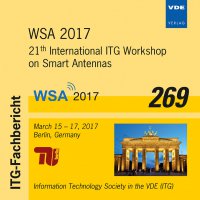First Visual Demonstration of Transmit and Receive Spatial Modulations Using the "Radio Wave Display"
Konferenz: WSA 2017 - 21th International ITG Workshop on Smart Antennas
15.03.2017 - 17.03.2017 in Berlin, Deutschland
Tagungsband: WSA 2017
Seiten: 7Sprache: EnglischTyp: PDF
Persönliche VDE-Mitglieder erhalten auf diesen Artikel 10% Rabatt
Autoren:
Phan-Huy, Dinh-Thuy; Malhouroux-Gaffet, Nadine; Buey, C.; Ratajczak, Philippe; Le Cornec, Alain; Gati, Azeddine; Sarrebourse, Thierry (Orange Labs, France)
Kokar, Yvan; Prevotet, Jean-Christophe; Helard, Maryline (INSA-Rennes, Farnce)
Rioult, Jean (Ifsttar, Luxondes, France)
Rachedi, Kammel; Ourir, Abdelwaheb; de Rosny, Julien (IMT Atlantique, France)
Leray, Christian (ATOS, France)
Pajusco, Patrice (ESPCI, France)
Di Renzo, Marco (Centrale-Sup�lec, France)
Inhalt:
In this paper, for the first time, visual demonstrations of new signal processing candidate techniques for the future fifth generation of mobile networks and the internet of things, called Transmit Spatial Modulation and Receive Spatial Modulation, respectively, are described. These techniques exploit multiple antennas to boost the spectral efficiency of the wireless link. However, compared to multiple-antenna systems, they use less Radio-Frequency modules, and they are expected to be lower in cost, size and energy consumption. They are thus promising to provide high data rate to/from small connected objects. In Transmit Spatial Modulation, the receiver, (a base station for instance), additionally to conventional demodulation, detects "where, in space, the signal comes from" to get additional data bits. In Receive Spatial Modulation, the receiver (a connected object for instance), additionally to conventional demodulation, detects "where, in space, the signal is arriving at" to get additional bits. Thanks to a new device called the Radio Waves Display and our spatial modulation test bed, for the first time, we visualize, in real time, the spatial repartition of the signal around and on the receiver. This enables even the general public to perform a spatial demodulation, in a visual manner, and understand intuitively, the concept.


